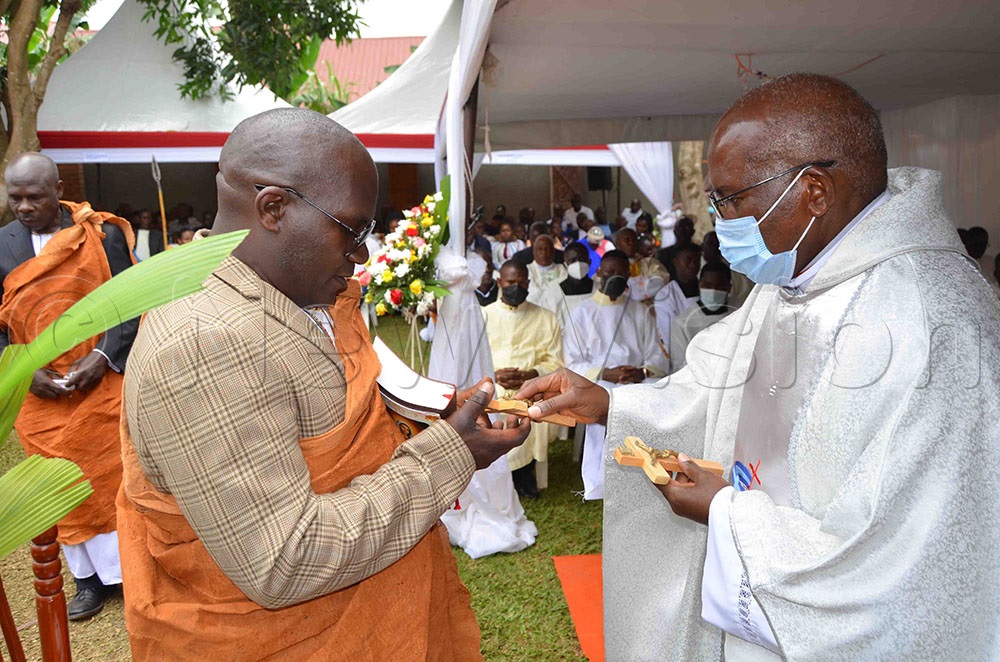Know the Ganda cultural symbols of the last funeral rites

Mathias Mazinga
Journalist @New Vision
One of the cultural practices of the Baganda that are rich with symbolic rituals is the celebration of the last funeral rites, traditionally known as Okwabya Olumbe (literally translated as: busting death).
The idea behind this practice is to declare an end to the grief/misery caused by the death of a loved one.
The practice involves among other things the installing of the heir or heiress of the deceased person, who upon his or her inauguration, takes over the responsibilities of the deceased to his or her family.

Ronald Ssembatya, the heir of the late Remegius Ssonko, (in backcloth) delivers his thanksgiving speech after his installation at the deceased's home at Nabbingo, in Wakiso district. On his right is his Lubuga (assistant), Annet Nakiganda.
The Ganda traditional practice of the last funeral rites is generally acknowledged as a good practice with very positive intentions.
The practice is strongly supported by the Roman Catholic Church as the Vicar General of the Metropolitan Archdiocese of Kampala, Msgr Charles Kasibante explains.
“The Catholic Church respects positive traditional practices such as the practice of celebrating the last funeral rites, which is practised by the people of Buganda.
The Church examined the practice and acknowledged its harmony with the Biblical idea of succession. That is why it was accommodated in the Catholic Divine Liturgy,” Kasibannte said.

Jajja Kiganda displays a gourd, which he says is a cultural symbol of Ganda family hospitality.
Although it has ecclesial approval, the practice also has critics who see its associated rituals as Satanic.
Some of the rituals that are under criticism include the adorning of the heir/heiress with backcloth, and the handing over of a spear and a gourd to the heir.
Jajja Kiganda, a cultural leader in the Kingdom of Buganda, nonetheless dismisses the concerns of critics calling them “baseless and unfounded.” He goes on to explain the ritualistic symbols, one by one.
“Before the coming of the Europeans, the Baganda used to wear backcloth. So, it is our cultural dress.
The spear is a symbol of protection; the heir is under obligation to protect from danger and harm the members of the family that have been put under their care. The knife that is given to the Lubuga (the assistant to the heir) is also a positive symbol.”
“A knife is used to peel food. It is also used to prune banana trees and other garden plants. So, the knife points to the expectation that the heir/heiress or Lubuga will have to grow food and feed the members of the family, and the guests who come to visit.
The gourd is a symbol of hospitality. When a visitor comes, they ae supposed to be given a drink to quench their thirst.

Msgr. Charles Kasibante (right) presents a crucifix to Ronald Ssembatya, the heir of the late Remegius Ssonko during the Eucharistic celebration for the deceased's last funeral rites function at Nabbingo, in Wakiso district.
The heir/heiress is given money in a basket. This is meant to encourage them to work hard and make the family financially self-sustaining.” Jajja Kiganda explained.
The Catholic Church does not just acknowledge the goodness of the practice of the last funeral rites but also complements its rituals as Msgr. Kasibante once again explains.
“After the heir or heiress has been installed, we invite them to participate in the thanksgiving mass, during which we also give them Christian items such as the Holy Bible, the Cross, and the Holy Rosary, which they are encouraged to use to get the strength, courage and wisdom that they need to carry out their responsibilities effectively,” Kasibante further explained.
The positive comments that Kasibante gives about the Ganda cultural practice of the last funeral rites does not mean it is free of negative cultural influences. He thus sends a stern warning to those who abuse its associated rituals.
“We know there are people who are not fully grounded in the Christian faith. Such mediocre Christians slide into syncretism by clinging to superstitious practices and combining them with the Christin practices.
We urge them to stop this or they risk demonizing what is ideally a good cultural practice that has also been Christianised,” Kasibante warned.

No Comment